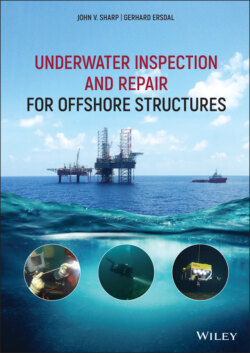Читать книгу Underwater Inspection and Repair for Offshore Structures - Gerhard Ersdal - Страница 17
1.3.2 Floating Structures
ОглавлениеSemi‐submersible units (Figure 4 d) have hulls, together with columns and pontoons, with sufficient buoyancy to enable the structure to float. Semi‐submersible platforms change draft by means of ballasting and de‐ballasting (changing the water level in seawater tanks). They are normally anchored to the seabed by mooring systems, usually a combination of chain and wire rope. However, semi‐submersibles can also be kept on station by dynamic positioning (DP), commonly used for semi‐submersibles as drilling units and flotels in deep water. The hull supports a deck on which various facilities for drilling and production can be installed. Semi‐submersible platforms are also being used for wind energy production, such as on the Kincardine wind farm in Scotland.
A tension leg platform (TLP) is of similar form to the semi‐submersible platform but is vertically moored by tension legs, which decrease the vertical motion significantly. A TLP is designed with excess buoyancy to ensure that the tension in the legs remains in all operational conditions.
A spar platform consists of a single moored large‐diameter vertical cylinder that is supporting the topside or a wind turbine. The cylinder is ballasted in the bottom (often by solid and heavy material) to provide stability. Spar‐type of structures are increasingly being used for floating wind energy production.
A ship‐shaped structure is a floating vessel similar in shape to a conventional ship, primarily used by the production and processing of hydrocarbons. These are often called a floating storage unit (FSU), a floating storage and offloading unit (FSO) or a floating production, storage and offloading unit (FPSO). The steel hull typically consists of plates in a main deck, side shells, turn‐of‐bilge and a bottom shell in addtion to tank tops and longitudinal bulkheads (wing tank bulkhead and centreline bulkhead) and transverse bulkheads. These main platings together form the ship beam. In most cases these plates are stiffened by girders and stiffeners. The plates are exposed to the loading from hydrostatic and dynamic pressure, which is transferred to the stiffeners and girder beams and into the structure. Ship‐shaped structures are usually moored to the seabed by chains or wire ropes, although they can also be held on station using a dynamic positioning system. These mooring systems will require underwater inspection and possibly repair.
Most of the details of floating structures can be inspected from the inside in near dry conditions and are, as such, not a part of this book. However, underwater inspection and repair of the mooring, anchors, outer skin, valves and attatchments are relevant and hence included in the book.
